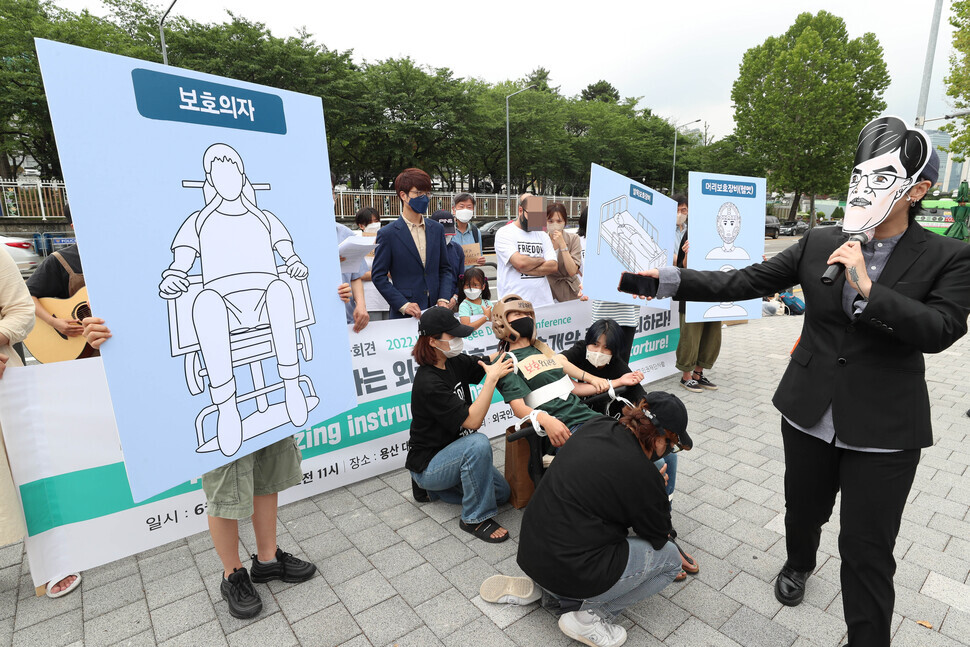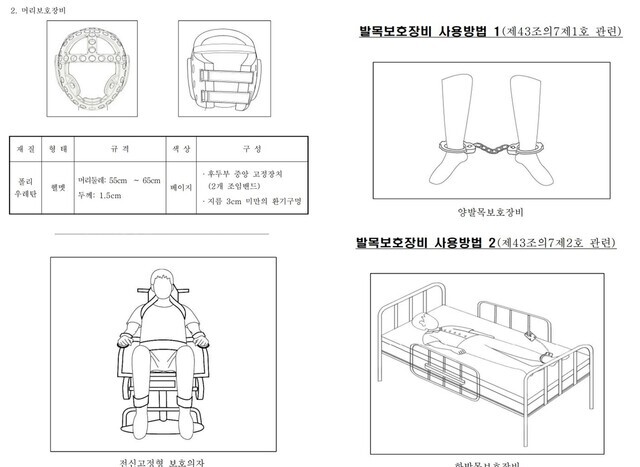hankyoreh
Links to other country sites 다른 나라 사이트 링크
Civic groups condemn immigration detention center protective gear as “torture devices”

“Justice Minister Han Dong-hoon stressed the word ‘justice’ in the ‘Ministry of Justice’ in his inaugural address. He said while visiting the Cheongju Immigration Detention Center that because non-Koreans under detention are not criminals, they must be treated with human dignity. Along with denouncing the Justice Ministry’s [plan to] legalize protective equipment [such as full-body restraint chairs], I wanted to tell Han that he ought to be ashamed of himself.” — Hong Se-hwa, director of the Jean Valjean Bank
After South Korea’s Ministry of Justice announced on May 25 that it would be equipping immigration detention centers with “protective equipment” such as ankle cuffs and restraint chairs as part of a revision to the immigration detention rules, civic groups are protesting that the revision amounts to the “legalization of torture.”
On June 20, which marked World Refugee Day, a civic group called Joint Action Committee on Incidents of Torture at Immigration Detention Centers held a press conference in front of the presidential office in Yongsan, Seoul, where they demanded that the Justice Ministry “immediately retract its rushed and terrible revision of the immigration detention rules, which would legalize torture.”
During a visit to the Cheongju Immigration Detention Center on June 10, Justice Minister Han Dong-hoon said that non-Koreans in detention “must be treated with human dignity.” Such treatment, he added, would be “a barometer illustrating the standards of the Republic of Korea.”
Despite Han’s remarks, the South Korean government plans to acquire equipment that would restrain the arms and legs of detainees, including ankle cuffs and restraint chairs.
The committee noted that the government hopes to acquire this equipment to remedy incidents of torture that occurred at the Hwasong Immigration Detention Center, in which a detainee was hog-tied, with his hands and feet bound behind his back.
“Considering that the rationale for revising the immigration detention rules is to better protect human rights for non-Koreans in detention and guarantee their lives and bodily safety, we must not allow that revision to create the regulatory grounds for legal torture,” the committee said.

According to the committee, the “protective equipment” that the Justice Ministry plans to acquire would have a negative impact on detainees’ physical and mental health.
“Protective headgear puts so much pressure on the face that it can create blisters and make it hard to breathe. Ankle cuffs keep people from walking and can injure the ankles. When a belt is cinched around one’s waist and the protective gear joining the handcuffs is raised to the solar plexus and tightened, it apparently feels like having your organs constricted,” said Kang Seong-jun, an activist with the Catholic Human Rights Committee.
“How can protective equipment be distinguished from torture equipment? Protective equipment is a modern form of corporal punishment,” Kang said.
Lee Han-jae, an attorney with the Korean law firm Duroo who represented a Moroccan who underwent brutal treatment, including hog-tying, at the Hwaseong Immigration Detention Center, pointed to the problems with the Justice Ministry’s revision of the regulation.
“Acquiring new equipment that places bodily freedom under extreme restraints, as the draft revision of the rules would do, was part of an inappropriate procedure under [current] administration practices that omits democratic deliberation. The current revision was announced abruptly, sidestepping all processes for collecting input not only from relevant government bodies, such as the National Human Rights Commission, but also from the human rights bureau inside the ministry itself,” Lee said.
Lee thinks the Justice Ministry should not be rewriting the rules to acquire protective equipment for non-Koreans waiting to be deported at immigration detention centers — who are not even criminal offenders — when the equipment used at prisons and other correctional facilities is defined in the Administration and Treatment of Correction Institution Inmates Act.
“When I saw the [Justice Ministry’s] new torture devices, I was overwhelmed by all the feelings I’d wanted to forget and tried to erase from my memory,” the former Moroccan detainee said during the press conference on Monday.
“Even now, my ankles hold traces of the wounds from the shackles [at the detention center]. I may be out [now], but my health has been compromised and I’m suffering from depression, anxiety and PTSD,” he said.
By Jang Ye-ji, staff reporter
Please direct questions or comments to [english@hani.co.kr]

Editorial・opinion
![[Editorial] Intensifying US-China rivalry means Seoul must address uncertainty with Beijing sooner than later [Editorial] Intensifying US-China rivalry means Seoul must address uncertainty with Beijing sooner than later](https://flexible.img.hani.co.kr/flexible/normal/500/300/imgdb/original/2024/0517/8117159322045222.jpg) [Editorial] Intensifying US-China rivalry means Seoul must address uncertainty with Beijing sooner than later
[Editorial] Intensifying US-China rivalry means Seoul must address uncertainty with Beijing sooner than later![[Column] When ‘fairness’ means hate and violence [Column] When ‘fairness’ means hate and violence](https://flexible.img.hani.co.kr/flexible/normal/500/300/imgdb/original/2024/0516/7417158465908824.jpg) [Column] When ‘fairness’ means hate and violence
[Column] When ‘fairness’ means hate and violence- [Editorial] Yoon must stop abusing authority to shield himself from investigation
- [Column] US troop withdrawal from Korea could be the Acheson Line all over
- [Column] How to win back readers who’ve turned to YouTube for news
- [Column] Welcome to the president’s pity party
- [Editorial] Korea must respond firmly to Japan’s attempt to usurp Line
- [Editorial] Transfers of prosecutors investigating Korea’s first lady send chilling message
- [Column] Will Seoul’s ties with Moscow really recover on their own?
- [Column] Samsung’s ‘lost decade’ and Lee Jae-yong’s mismatched chopsticks
Most viewed articles
- 1For new generation of Chinese artists, discontent is disobedience
- 2[Editorial] Transfers of prosecutors investigating Korea’s first lady send chilling message
- 3[Exclusive] Unearthed memo suggests Gwangju Uprising missing may have been cremated
- 4[Editorial] Intensifying US-China rivalry means Seoul must address uncertainty with Beijing sooner t
- 5S. Korea “monitoring developments” after report of secret Chinese police station in Seoul
- 6N. Korean media upgrades epithet for leader’s daughter from “beloved” to “respected”
- 7Yoon says concern about biased diplomacy is being incited by “communist totalitarian forces”
- 8[Column] US troop withdrawal from Korea could be the Acheson Line all over
- 9Xi, Putin ‘oppose acts of military intimidation’ against N. Korea by US in joint statement
- 1060% of young Koreans see no need to have kids after marriage